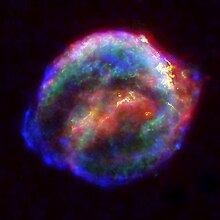
SN 1604, also known as Kepler's Supernova, Kepler's Nova or Kepler's Star, was a supernova of Type Ia that occurred in the Milky Way, in the constellation Ophiuchus. Appearing in 1604, it is the most recent supernova in our own galaxy to have been unquestionably observed by the naked eye, occurring no farther than 6 kiloparsecs or about 20,000 light-years from Earth.
Visible to the naked eye, Kepler's Star was brighter at its peak than any other star in the night sky, with an apparent magnitude of −2.5. It was visible during the day for over three weeks. Records of its sighting exist in European, Chinese, Korean and Arabic sources.
It was the second supernova to be observed in a generation (after SN 1572 seen by Tycho Brahe in Cassiopeia). No further supernovae have since been observed with certainty in the Milky Way, though many others outside our galaxy have been seen since S Andromedae in 1885. SN 1987A in the Large Magellanic Cloud was easily visible to the naked eye.
Evidence exists for two Milky Way supernovae whose signals would have reached Earth c. 1680 and 1870 — Cassiopeia A, and G1.9+0.3 respectively. There is no historical record of either having been detected in those years probably as absorption by interstellar dust made them fainter.
The supernova remnant resulting from Kepler's supernova is considered to be one of the prototypical objects of its kind and is still an object of much study in astronomy.
Distance: 20,000 light years
Radius: Unknown
Mass: Unknown
Consists of: Mainly H2.
